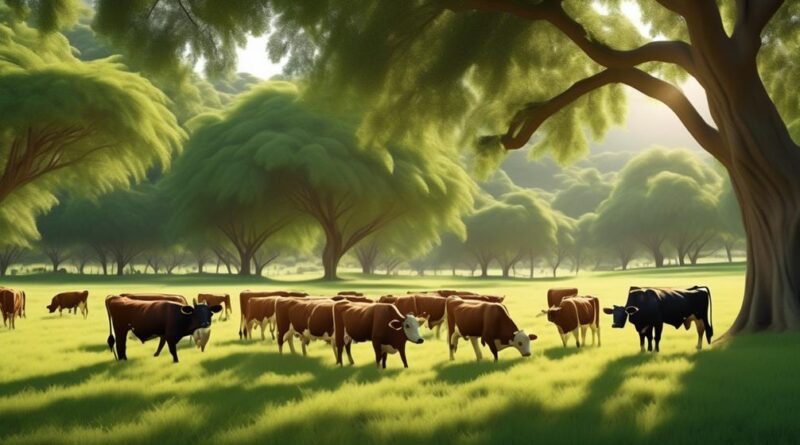What Are the Benefits of Agroforestry With Cattle?
Have you ever considered the potential benefits of integrating agroforestry with cattle farming? The combination of trees and livestock can offer a range of advantages that extend beyond traditional agricultural practices.
From improved soil health to enhanced biodiversity, the integration of agroforestry and cattle presents a compelling case for sustainable and efficient land management.
But what specific advantages can this approach provide, and how might it transform the way we think about livestock production and environmental conservation?
Enhanced Soil Health
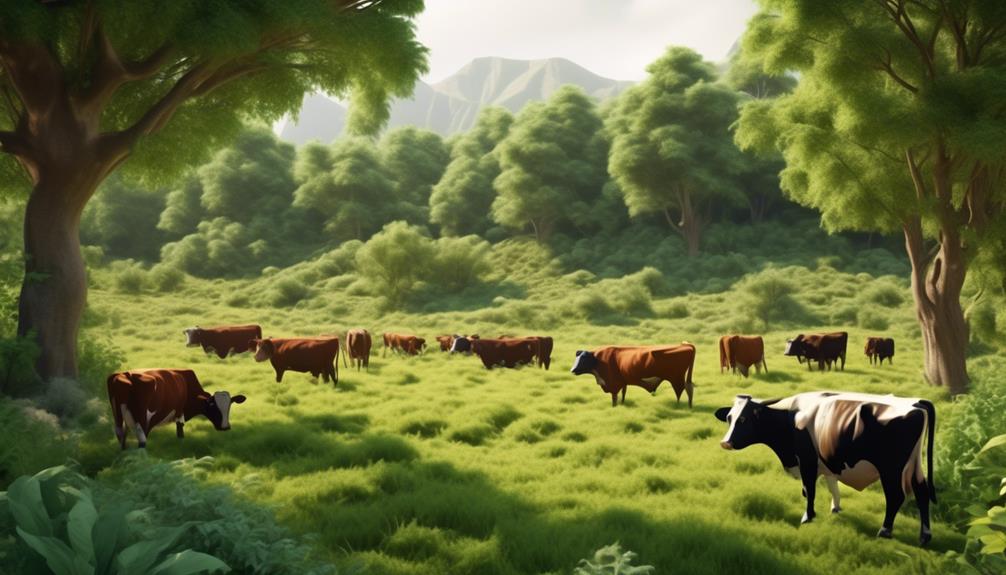
Enhance soil health in agroforestry with cattle by integrating trees and livestock grazing to improve soil structure and nutrient cycling. This integrated approach has proven to lead to increased productivity and sustainable land use.
By allowing livestock to graze among trees, their manure becomes a natural fertilizer, enhancing soil fertility, and reducing the need for chemical inputs. The presence of trees in the agroecosystem helps in stabilizing the soil structure, preventing erosion, and reducing nutrient runoff. As a result, the soil becomes more resilient and better capable of supporting diverse plant life, leading to increased productivity.
Furthermore, the combination of trees and livestock grazing in agroforestry systems contributes to sustainable land use. Trees provide shade for the cattle, reducing heat stress and improving animal welfare. The presence of trees also encourages biodiversity, creating a more balanced ecosystem and reducing the need for external interventions.
This integrated approach minimizes the environmental impact of cattle farming while maximizing the efficient use of land. Additionally, the trees contribute to carbon sequestration, mitigating the greenhouse effect and helping to combat climate change.
Improved Carbon Sequestration
Incorporating trees into cattle grazing areas significantly improves carbon sequestration, contributing to the mitigation of greenhouse gas emissions. Agroforestry systems with cattle play a crucial role in climate impact by sequestering carbon dioxide from the atmosphere and storing it in trees and soil. Trees act as carbon sinks, absorbing CO2 during photosynthesis and storing it in their biomass, thereby reducing the concentration of greenhouse gases in the atmosphere. This not only helps in combating climate change but also enhances the overall sustainability of cattle farming.
Grazing management within agroforestry systems also contributes to improved carbon sequestration. By strategically managing cattle grazing in these areas, the impact on soil compaction is minimized, allowing for better soil structure and increased organic matter content. This, in turn, enhances the soil's capacity to store carbon, further aiding in carbon sequestration.
Additionally, the presence of trees provides shade for the cattle, reducing heat stress and thus lowering their methane production, another potent greenhouse gas.
Diverse Forage Options
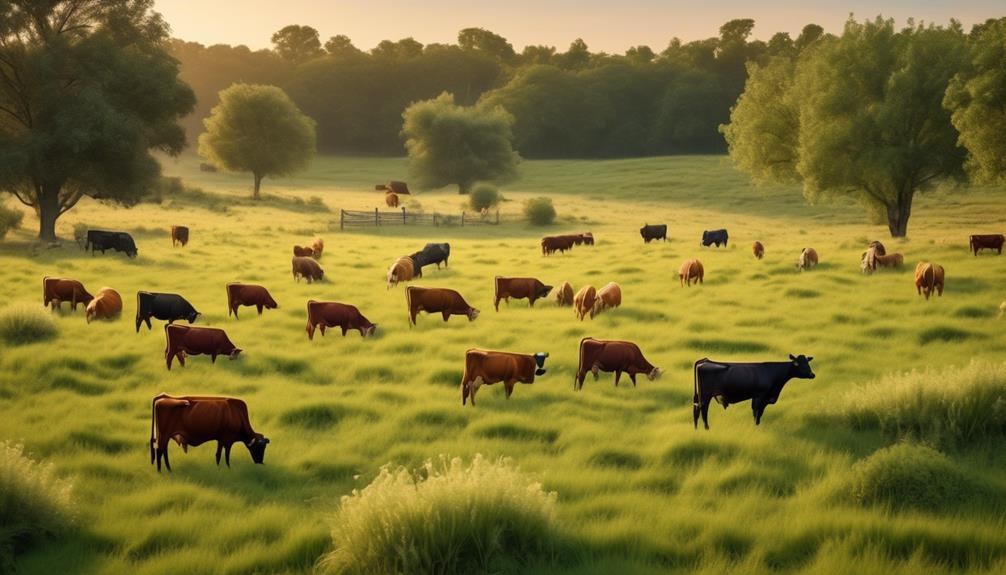
With diverse forage options, you can provide a varied and nutritionally balanced diet for your cattle, promoting their health and productivity. By incorporating rotational grazing and silvopasture systems, you can enhance your cattle's diet and overall well-being. Here are some benefits of diverse forage options:
- Rotational Grazing: Implementing rotational grazing allows you to divide your pasture into smaller sections, moving your cattle through these areas in a systematic manner. This practice helps prevent overgrazing, promotes grass regrowth, and allows forage to recover, ensuring a continuous and healthy food supply for your cattle.
- Silvopasture Systems: Introducing trees and shrubs into your pasture creates a silvopasture system, offering diverse forage options for your cattle. Trees provide shade, shelter, and additional forage such as leaves, fruits, and nuts, enriching the cattle's diet and providing a more natural environment for them to thrive.
- Nutritional Variety: Diverse forage options offer a wide range of nutrients, minerals, and vitamins, contributing to a more balanced diet for your cattle. This variety can lead to improved overall health, better weight gain, and enhanced reproductive performance.
- Environmental Benefits: Incorporating diverse forage options through rotational grazing and silvopasture systems can also have positive impacts on soil health, water retention, and biodiversity, creating a more sustainable and resilient agroforestry system.
Reduced Erosion and Runoff
To reduce erosion and runoff, implement agroforestry practices that integrate trees and shrubs with your cattle grazing areas. Agroforestry helps in erosion control by stabilizing the soil with deep-rooted trees and shrubs, which hold the soil together and prevent it from being washed away by rainfall or runoff. The canopy of trees also helps to reduce the impact of raindrops on the soil, further preventing erosion. Additionally, the roots of trees and shrubs enhance water infiltration, allowing the soil to absorb more water and reducing surface runoff.
By incorporating agroforestry with cattle grazing, you can significantly reduce the amount of runoff entering nearby water bodies. This not only helps in water conservation but also contributes to maintaining the quality of water in the surrounding ecosystem. Trees and shrubs act as natural buffers, filtering and slowing down the movement of water, which helps to prevent sediment and other pollutants from being carried into streams and rivers.
Furthermore, the presence of trees and shrubs in grazing areas provides shade for the cattle, reducing their need to congregate near water sources. This can help to minimize soil compaction and erosion around these critical areas. The combination of agroforestry and cattle grazing creates a sustainable and balanced ecosystem that supports both agricultural production and environmental conservation.
Natural Shade and Shelter
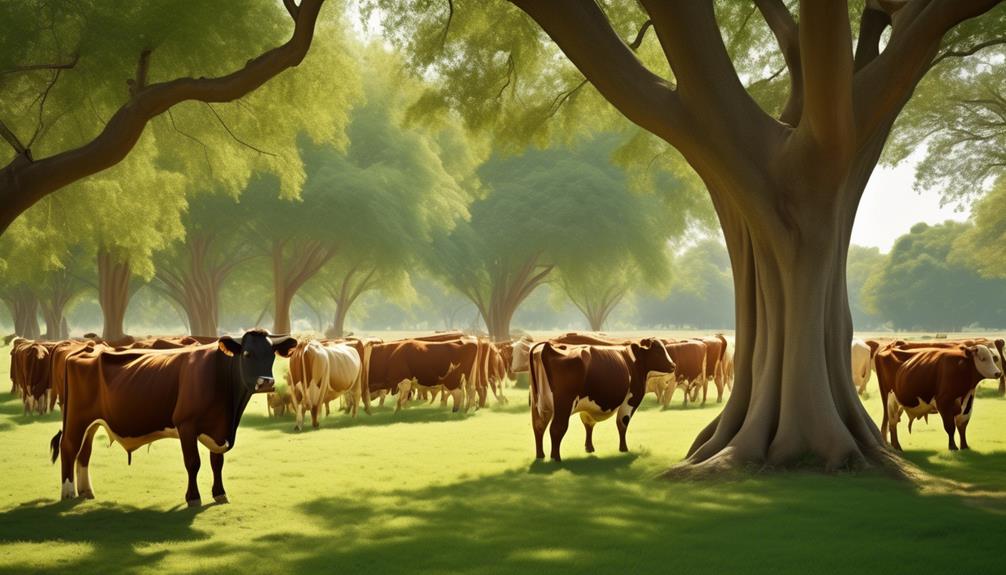
Shade and shelter for your cattle can be naturally provided by the trees and shrubs integrated into your grazing areas through agroforestry practices, reducing the need for congregation near water sources. This not only benefits the animals but also has positive environmental impacts.
- Animal Welfare: Natural shade and shelter contribute to improved animal welfare by providing relief from the heat and protection from inclement weather. Cattle are less stressed and more comfortable, which can lead to better overall health and productivity.
- Grazing Behavior: The presence of trees and shrubs in grazing areas influences the behavior of cattle. They're more likely to spread out and graze evenly across the pasture, preventing overgrazing in specific areas. This promotes healthier grass growth and reduces soil erosion.
- Microclimate Regulation: Trees play a crucial role in regulating microclimates. They provide cooling effects through transpiration and create pockets of lower temperatures. This helps in maintaining optimal conditions for the cattle, especially during hot weather.
- Environmental Benefits: The natural shade and shelter offered by agroforestry practices contribute to overall environmental benefits. It reduces the need for artificial structures, thereby lowering energy consumption. Additionally, the trees and shrubs aid in carbon sequestration and contribute to biodiversity.
Incorporating agroforestry into your cattle management practices not only enhances animal welfare but also brings about positive changes in the surrounding environment, making it a sustainable and holistic approach to cattle farming.
Enhanced Biodiversity
Enhanced biodiversity in agroforestry systems results from the diverse habitat created by integrating trees and shrubs with grazing areas, supporting a wider range of plant and animal species. The integration of trees and shrubs in grazing areas provides various ecological niches and resources, leading to habitat restoration and wildlife conservation. The presence of diverse vegetation and topographic features in agroforestry landscapes offers nesting sites, shelter, and food sources for a multitude of wildlife species. This encourages the presence of a wide array of insects, birds, mammals, and other organisms, contributing to the overall ecological balance and species richness.
Agroforestry systems not only provide forage and shade for cattle but also support a rich and vibrant ecosystem. The presence of diverse plant species aids in soil conservation and nutrient cycling, while also promoting the health and diversity of soil microorganisms. This, in turn, supports a healthier and more robust food web, enhancing the overall resilience of the agroecosystem.
Furthermore, the varied vegetation in agroforestry systems creates corridors and patches of natural habitat, promoting connectivity and facilitating the movement of wildlife across the landscape. This interconnected habitat structure is crucial for the conservation of species and the maintenance of genetic diversity within populations.
Integrated Pest Management
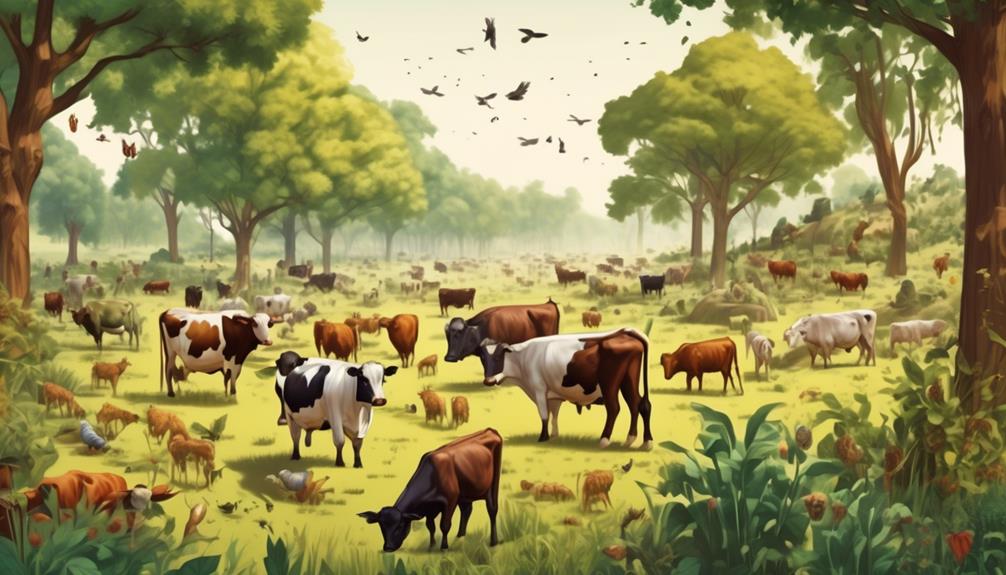
The diverse habitat created by integrating trees and shrubs with grazing areas in agroforestry systems not only supports biodiversity but also provides a natural foundation for implementing integrated pest management strategies.
This approach to pest management in agroforestry systems offers several advantages, including:
- Pest Control: The presence of diverse plant species in agroforestry systems creates a natural balance that helps control pests. Certain tree species can emit compounds that repel insects, while others attract beneficial insects that prey on pests, contributing to a more balanced ecosystem.
- Environmental Balance: Agroforestry systems promote a balanced and resilient environment, which is crucial for effective pest management. The presence of trees and shrubs provides habitat for birds, bats, and other natural predators of pests, aiding in pest control without the need for chemical intervention.
- Sustainable Agriculture: Integrated pest management in agroforestry aligns with the principles of sustainable agriculture. By reducing the reliance on synthetic pesticides, agroforestry systems contribute to the long-term health and productivity of the land, ensuring sustainable agricultural practices.
- Ecological Resilience: The combination of trees, shrubs, and grazing areas enhances the ecological resilience of the agroforestry system. This resilience helps in naturally mitigating pest pressures and reduces the risk of pest outbreaks, contributing to the overall health and stability of the agricultural environment.
Implementing integrated pest management within agroforestry systems not only supports sustainable agriculture but also fosters ecological resilience and environmental balance, creating a holistic approach to pest control.
Economic Diversification
Considering the potential for diversifying your income streams, agroforestry with cattle presents various economic opportunities. By integrating trees and livestock, you can tap into market opportunities that go beyond traditional cattle farming. Agroforestry with cattle allows you to diversify your products, such as timber, fruits, and nuts from trees, in addition to the income generated from cattle. This diversification spreads the risk across different enterprises, providing a form of risk management against fluctuations in market prices or unexpected events impacting a single product.
Moreover, agroforestry with cattle contributes to income stability by enabling you to harness multiple revenue streams. The combination of trees and livestock optimizes resource utilization, as the trees provide shade and forage, reducing the need for supplementary feed and improving overall herd health. This not only lowers input costs but also increases the resilience of your farming system.
Through agroforestry, you can access niche markets for sustainably produced timber, fruits, and specialty livestock products, potentially commanding higher prices and enhancing the overall profitability of your operation.
Frequently Asked Questions
What Are the Best Cattle Breeds for Agroforestry Systems?
For agroforestry systems, some cattle breeds thrive better than others. Consider breeds like Red Angus or Hereford for their adaptability to diverse environments and foraging behavior, which make them well-suited for agroforestry practices.
How Can Agroforestry With Cattle Help to Mitigate the Effects of Climate Change?
To mitigate the effects of climate change, agroforestry with cattle can help through carbon sequestration and proper grazing management. By incorporating trees into pasture systems, you can enhance carbon storage and reduce greenhouse gas emissions.
What Are the Potential Challenges of Implementing Agroforestry With Cattle?
Implementing agroforestry with cattle may pose challenges in grazing management and soil health. However, with proper planning and monitoring, these challenges can be addressed effectively to ensure the success of the agroforestry system.
How Does Agroforestry With Cattle Impact Water Usage and Availability?
When practicing agroforestry with cattle, impact on soil fertility is significant as trees can help retain water and prevent erosion, benefiting water usage and availability. Proper grazing management techniques further support sustainable water resources.
What Are the Long-Term Economic Benefits of Integrating Trees and Cattle on a Farm or Ranch?
When you integrate trees and cattle on a farm or ranch, you can achieve long-term profitability by practicing sustainable methods. Agroforestry with cattle can enhance soil fertility, provide shade for livestock, and diversify income sources.
Conclusion
In conclusion, agroforestry with cattle offers a range of benefits such as improved soil health, carbon sequestration, diverse forage options, reduced erosion and runoff, natural shade and shelter, enhanced biodiversity, integrated pest management, and economic diversification.
By integrating trees and livestock, farmers can create a sustainable and resilient agricultural system that supports both environmental and economic goals.
So, consider implementing agroforestry with cattle to reap these valuable benefits on your farm.
